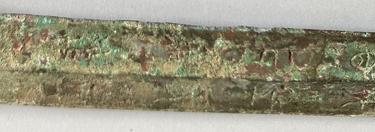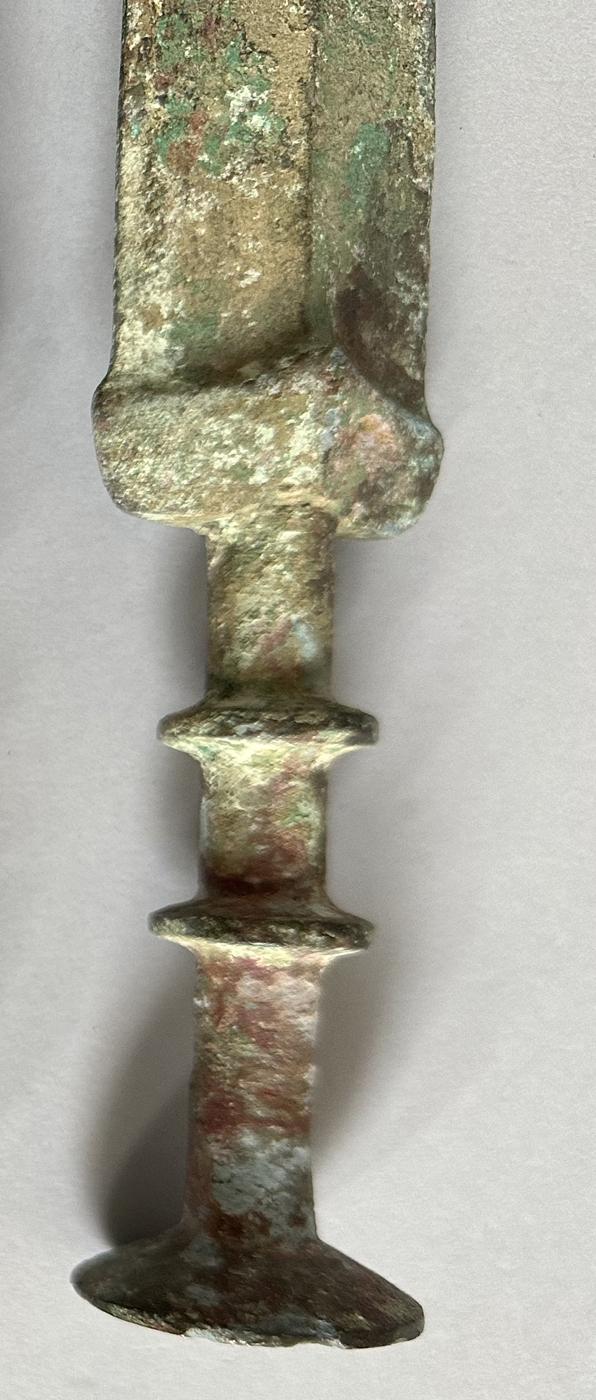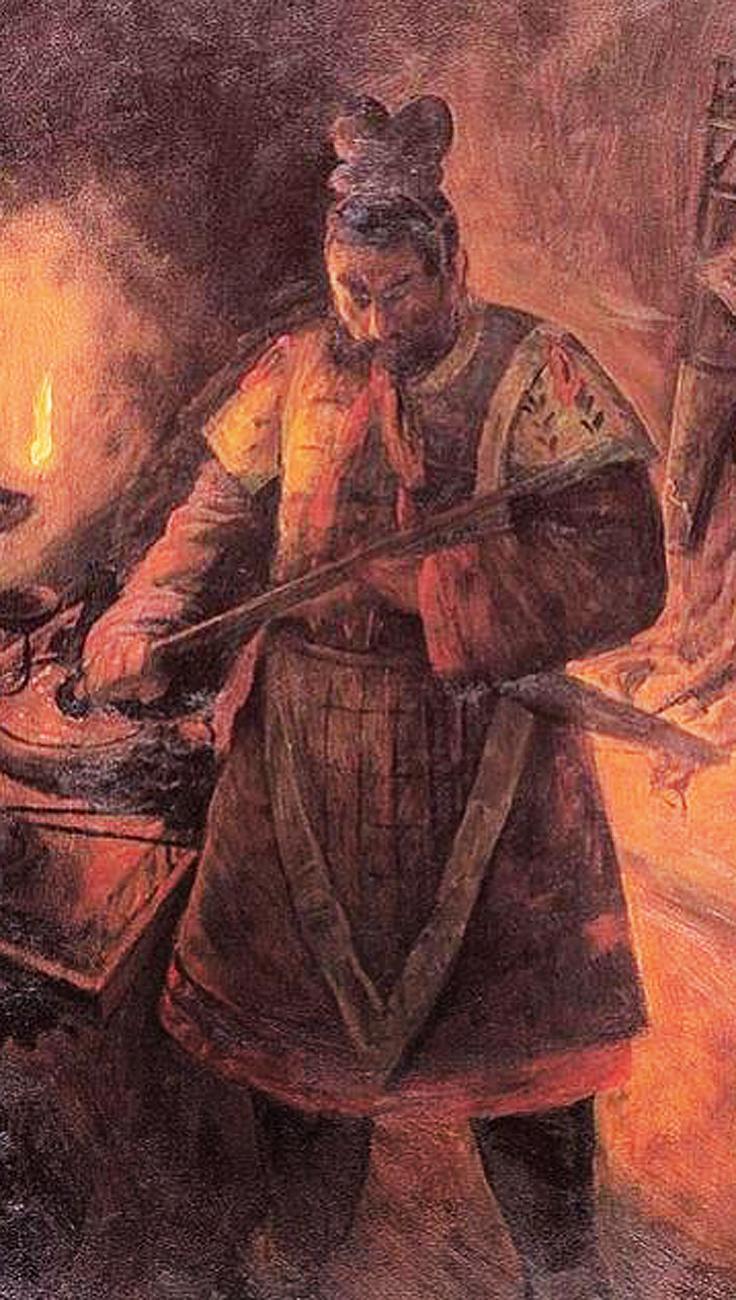A Rare, Archaic Chinese Warrior's Bronze Jian Sword, Engraved with Seal Script, Around 2,300 to 2,800 Years Old, From the Zhou Dynasty to the Qin Dynasty, Including the Period of the Great Military Doctrine 'The Art of War' by General Sun-Tzu
The blade bears the maker's name in ancient script, and potentially for whom it was made. This is hopefully being translated for us by a scholar from a Chinese museum, who arrived again to film it here in our shop this week for his chief museum curator and researcher in China.
Chinese Bronze 'Two Ring' Jian sword, of tin rich over bronze alloy construction, engraved with two rows of archaic lesser or greater seal script, used in the era of the Seven Kingdoms period, likely in the Kingdom of Wu, up to the latter part of the Eastern Zhou dynasty (475 – 221 BC). It is incredibly rare to find a sword from this period of ancient history, from any country, that has provenance script of any kind engraved upon it, it may well detail the name of the King for whom the sword was made, and other details, the swordmaker who made it, and even the name of the man by whom it was used. The surface is covered in superb patination and age encrustations with traces of tinning.
From a collection of antiquities, swords daggers, and rings, many pieces sold for the part benefit of the Westminster Abbey fund, and the Metropolitan Museum fund
This sword is the near pair, but slightly longer than another we acquired from the same British collection two years ago, and previously sold. Also that sword and this sword bears engraved script, in the same ancient Chinese character form, but with slight differences on the right row. This would likely indicate they came from the same original ancient Chinese location, tomb etc, a hundred plus years ago.
Tinning was used in China from the Eastern Zhou period (770–221 BC), and various methods were employed. A special technique was amalgam tinning, documented since the seventh century BC
Dazhuan (大篆), or Greater Seal script. This stage of Chinese writing flourished from the Late Shang to the Western Chou dynasties (1100 BCE to 700 BCE). Unlike Jiaguwen, which was carved on bones, Dazhuan mainly appeared on cast bronze vessels. In fact, Jiaguwen and Dazhuan overlapped in time, and they might have been the same script but as they were inscribed on different materials their visual styles differ due to the quality of the surfaces.
Xiaozhuan, (小篆), or Lesser Seal script. This elegant script is the direct parent of the modern, unsimplified Chinese script. Not only are Xiaozhuan characters are more stylized and less "pictographic" like Jiaguwen and Dazhuan, but also exhibits systematic and extensive use of radicals much like modern Chinese. This script has survived the passage of time and continues to be used in the present age in calligraphy and seals.
Swords of this type are called “two-ring” swords because of the prominent rings located on the hilt. this is the very type of sword used by the warriors serving under the world renowned General Sun Tzu, in the Kingdom of Wu, who is thought by many to be the finest general, philosopher and military tactician who ever lived. His 2500 year old book on the methods of warfare, tactics and psychology are still taught and highly revered in practically every officer training college throughout the world.
We show a painting in the gallery of a chariot charge by a Zhou dynasty warrior armed with this very form of sword.
The Chinese term for this form of weapon is “Jian” which refers to a double-edged sword. This style of Jian is generally attributed to either the Wu or the Yue state. The sword has straight graduated edges reducing to a pointed tip, which may indicate an earlier period Jian.
The blade is heavy with a midrib and tapered edges with seal script engraving on both sides of the bottom section of the blade near the hilt. See the photo in the gallery that shows a close up of the section of blade with the seal script.
A very impressive original ancient Chinese sword with a long, straight blade with a raised, linear ridge down its centre. It has a shallow, short guard. The thin handle would have had leather or some other organic material such as leather or hemp cord, wrapped around it to form a grip. At the top is a broad, round pommel.
Although the manufacturing techniques used may have varied from region to region, it is generally believed that such tin-rich decoration was achieved by a deliberate tinning process,including cold-tinning hot-tinning (dipping or wiping) the use of a mercury-tin amalgam ,or the application of a tin-rich paste.
In 1965 a similar form sword from the same era was found in an ancient tomb in Hubei, it was also engraved with seal script, but of a different form. The Sword of Goujian (越王勾践剑) is a tin bronze sword, renowned for its unusual sharpness, intricate design and resistance to tarnish rarely seen in artifacts of similar age. The sword is generally attributed to Goujian, one of the last kings of Yue during the Spring and Autumn period.
On one side of the Hubei sword’s blade, two columns of text are visible. Eight characters are written in an ancient script, now known as Bird-worm seal script (literally "birds and worms characters", owing to the intricate decorations of the defining strokes), a variant of seal script. Initial analysis of the text deciphered six of the characters, "King of Yue" (越王) and "made this sword for his personal use" (自作用劍). The remaining two characters were assumed to be the name of the particular King of Yue.
The Seven Kingdom or Warring States period in Chinese history was one of instability and conflict between many smaller Kingdom-states. The period officially ended when China was unified under the first Emperor of China, Qin pronounced Chin Shi Huang Di in 221 BC. It is from him that China gained its name.
The Zhou Dynasty (1046-256 BCE) was among the most culturally significant of the early Chinese dynasties and the longest lasting of any in China's history, divided into two periods: Western Zhou (1046-771 BCE) and Eastern Zhou (771-256 BCE). It followed the Shang Dynasty (c. 1600-1046 BCE), and preceded the Qin Dynasty (221-206 BCE, pronounced “chin”) which gave China its name.
In the early years of the Spring and Autumn Period, (770-476 BC) chivalry in battle was still observed and all seven states used the same tactics resulting in a series of stalemates since, whenever one engaged with another in battle, neither could gain an advantage. In time, this repetition of seemingly endless, and completely futile, warfare became simply the way of life for the people of China during the era now referred to as the Warring States Period. The famous work The Art of War by Sun-Tzu (l. c. 500 BCE) was written during this time, recording precepts and tactics one could use to gain advantage over an opponent, win the war, and establish peace.
Sun Tzu was a Chinese general, military strategist, writer, and philosopher who lived in the Eastern Zhou period of ancient China. Sun Tzu is traditionally credited as the author of The Art of War, an influential work of military strategy that has affected both Western and East Asian philosophy and military thinking. His works focus much more on alternatives to battle, such as stratagem, delay, the use of spies and alternatives to war itself, the making and keeping of alliances, the uses of deceit, and a willingness to submit, at least temporarily, to more powerful foes. Sun Tzu is revered in Chinese and East Asian culture as a legendary historical and military figure. His birth name was Sun Wu and he was known outside of his family by his courtesy name Changqing The name Sun Tzu by which he is more popularly known is an honorific which means "Master Sun".
Sun Tzu's historicity is uncertain. The Han dynasty historian Sima Qian and other traditional Chinese historians placed him as a minister to King Helü of Wu and dated his lifetime to 544–496 BC. Modern scholars accepting his historicity place the extant text of The Art of War in the later Warring States period based on its style of composition and its descriptions of warfare. Traditional accounts state that the general's descendant Sun Bin wrote a treatise on military tactics, also titled The Art of War. Since Sun Wu and Sun Bin were referred to as Sun Tzu in classical Chinese texts, some historians believed them identical, prior to the rediscovery of Sun Bin's treatise in 1972.
Sun Tzu's work has been praised and employed in East Asian warfare since its composition. During the twentieth century, The Art of War grew in popularity and saw practical use in Western society as well. It continues to influence many competitive endeavours in the world, including culture, politics, business and sports.
The ancient Chinese people worshipped the bronze and iron swords, where they reached a point of magic and myth, regarding the swords as “ancient holy items”. Because they were easy to carry, elegant to wear and quick to use, bronze swords were considered a status symbol and an honour for kings, emperors, scholars, chivalrous experts, merchants, as well as common people during ancient dynasties. For example, Confucius claimed himself to be a knight, not a scholar, and carried a sword when he went out. The most famous ancient bronze sword is called the “Sword of Gou Jian”.
The Warring States period saw a transition in military styles, from bronze weaponry and chariot-based fighting to iron and cavalry. However, the old period was still revered. Despite the cost of manufacturing bronze swords like this on a mass scale, this particular style of duan jian – a double-edged straight sword – was used in China for approximately 2,500 years. Finely made bronze weapons such as this one were signs of prestige, wealth, and fighting prowess used in both ceremonial and funerary contexts. For example, swords were worn by the Emperor and his officials in ceremonial or official dress, attached to the belt with jade ornaments.
This is one of a stunning collection of original archaic bronze age Zhou dynasty weaponry we have just acquired. Many are near identical to other similar examples held in the Metropolitan in New York, the British royal collection, and such as the Hunan Provincial Museum, Hunan, China. As with all our items, every piece is accompanied by a certificate of authenticity. Just over 26 inches long overall.
From the Tony Dove F.S.A. Collection, formed circa 1970's, one of England’s most revered and highly respected collectors, and publisher on learned reports on the identification and electronic analysis of the construction of ancient Chinese swords. He was especially devoted to collecting early silver, & he was a past honorary President of London’s Silver Spoon Society.
Other bronze swords bearing inscriptions inlaid in gold include the example dated to the 5th century BC in the Freer Gallery of Art, illustrated by T. Lawton, Chinese Art of the Warring States Period, Change and Continuity, 480-222 BC , Washington, DC , 1982, p. 70-71, no. 28, and one in the Musée Guimet dated 5th-4th century BC, illustrated by C. Delacour, De bronze, d'or et d'argent, Sumptuary Arts of China , Paris, 2001, p. 131. Both the Freer sword and the Guimet sword bear the same twenty-character inscription, arranged in ten characters to each side, which Thomas Lawton translates as, "On the auspicious day jen-wu, this sword was made for righteous use . "
Code: 24840
4750.00 GBP









